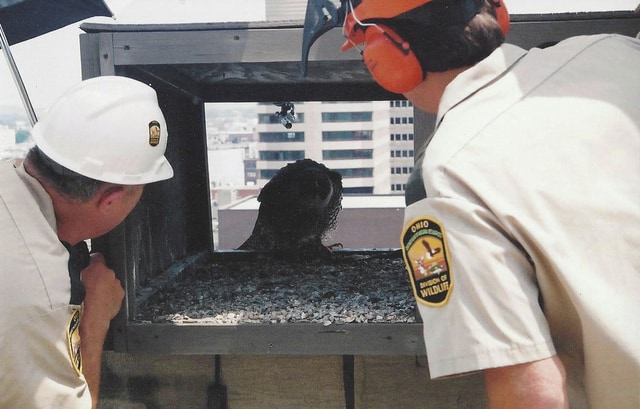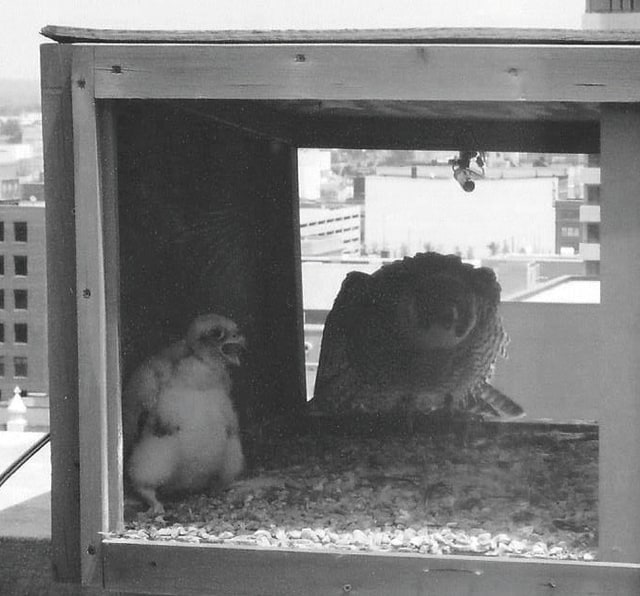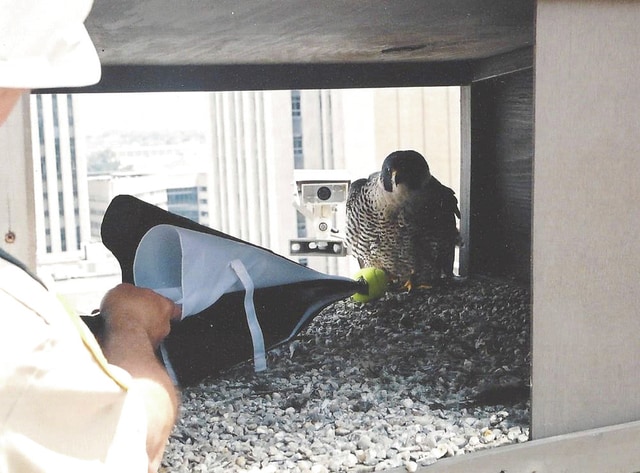






Names like Baltimore, Rachel, Mercury, Snoball, Dunbar, Ludlow, Orville and Wilbur all come to mind as some of the Dayton falcons I’ve photographed and wrote about over the years. Let’s take a short stroll through the history of the Peregrine Falcon reintroduction and recovery in Dayton.
The falcons, identified as Mercury and Rachel, first appeared in Dayton in 1992. They began nesting at the Lazarus Building but did not produce any young the first year. Two young were raised in 1993. Then in 1994 Rachel was not to be seen and was later found dead after apparently becoming trapped in a building. Two new females appeared. The one from Baltimore succeeded in winning the battle for the right to mate with Mercury and settled into the nest.
My involvement started in 1999 when the falcons were nesting at the Lazarus Building. It was an adventure to use the freight elevator to reach the top of the now empty building. The first signs of the scheduled activities were in the Lazarus parking garage where signs were posted warning people on the rooftop that there may be falcon attacks today. It seemed that both Baltimore and Mercury knew something was up as they circled the area even before we headed up to the sixth floor. They produced one chick in 1999. Mercury and Baltimore raised an incredible sixteen young from 1995 to 1999. They became temporarily homeless when the Lazarus Building was demolished.
The Dayton peregrines established a new nesting site on the Liberty Bank (formerly Holman) Building in 2000. The Dayton falcons were one set of twelve nesting pairs in the State of Ohio. Three falcon chicks hatched over Mother’s Day weekend. Unfortunately the nest was lost. The chicks were last observed on May 24, 2000. In 2001 Mercury and Baltimore called the 5/3 Center Building home and successfully nested. They raised 2 female and 1 male offspring. Baltimore, the female, was badly injured and died in the summer of 2001.
In 2002, the Ohio Division of Wildlife, with support and cooperation from Greene County officials, installed a peregrine falcon nesting box in the Greene County Courthouse clock tower in early 2002. I was there to both help install the box. There had been numerous reported sightings of a peregrine falcons in the Xenia area. Unfortunately no falcons ever called Xenia home.
Meanwhile back in Dayton for 2002, a new female became Mercury’s third mate. She was from Cleveland and named Snoball. Mercury and Snoball moved to a new nest site on the AT&T Building, where they raised three young named Amelia, Terra, and Talon (AT&T) in 2002.
2003 was a banner year for falcons in Ohio. It seemed the birds were joining all Ohioans to honor the 100th Anniversary of the Wright Brothers first flight. Thirteen pairs of peregrine falcons successfully hatched and fledged a total of 31 young falcons. Mercury and Snoball had two young which were, appropriately, named Orville and Wilbur.
A record 54 peregrine falcon chicks fledged in 2004 from the fifteen falcon nests across the state. Five pairs in Cleveland, along with individual pairs in Aberdeen, Akron, Canton, Cincinnati, the Village of Cleves, Dayton, Ironton, Lakewood, Lima, and Toledo all produced between two and four young per nest. A pair was observed in downtown Columbus, but no eggs were produced.
The record production continued in 2005 and 2006. In 2005, a total of 57 peregrine falcon chicks were produced from 18 nests while 2006 saw another record of 60 peregrine falcon chicks fledged from 18 nests across the state. Five falcon pairs in Cleveland, along with individual pairs in Aberdeen (Brown County), Akron, Canton, Cincinnati, the Village of Cleves (Hamilton County), Columbus, Dayton, Eastlake, Ironton, Lakewood, Lima, Toledo, and Youngstown all produced between one and four young per nest. Two territorial falcon pairs were located with one pair near Lorain and one in southern Cuyahoga County.
2008 again saw changes in the Dayton falcons as both Snoball and Mercury disappeared. Mercury was an exceptional peregrine who lived nearly twenty-years. He had three mates and successfully raised twenty-six young in downtown Dayton. Quite a record when the average lifespan is approximately six years! A new pair appeared in the skies over Dayton. They remain a mystery pair as the female was not banded. The male had a band but the biologists were never been able to read the entire identification. There were three eggs laid but only two chicks hatched in 2008.
Changes continued in 2010 with Daniel and Dayton successfully hatching two chicks. The male was named Dunbar and the female named Ludlow. Daniel was hatched from the Cincinnati nest in 2000 and the unbanded female was nicknamed “Dayton”. Wildlife officials were not able to obtain any prior information about her; however she is likely the same unbanded female that appeared in 2008.
2014 continued the successful nesting in Dayton although with some mystery still surrounding the pair. The female was thought to be the same female nicknamed Dayton. The male is thought to be Daniel although observers were unable to get a good look at his leg bands. The pair has successfully hatched three young that year.
So McKinley, Grant and Harrison in 2015 joined a long list of peregrine falcons born at the top of Dayton. Exact counts as to the actual survival or what happened to all the falcon chicks is not known. The first year is the toughest on the birds. On average, fifty percent of the chicks will actually make it through the first year. After that survival becomes much easier for the peregrines. What is known is that Ohio birds have been spotted in Canada and New York. Dayton has played a key role in the recovery of the Peregrine Falcon both in Ohio and nationally. I am fortunate that I could observe and photograph so many of the Dayton falcons over many years.

